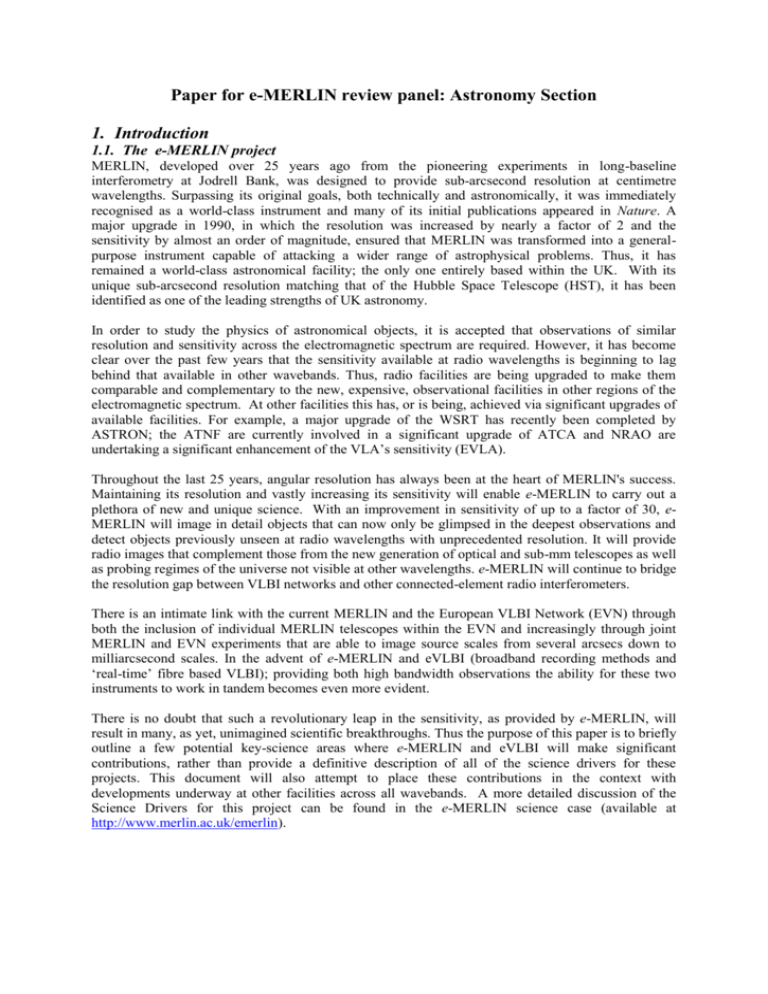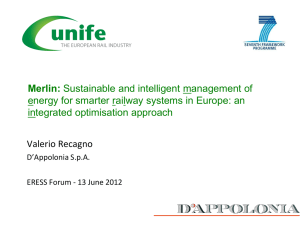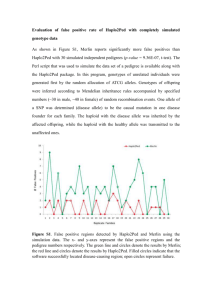e-MERLIN Review Introduction - Jodrell Bank Centre for Astrophysics
advertisement

Paper for e-MERLIN review panel: Astronomy Section 1. Introduction 1.1. The e-MERLIN project MERLIN, developed over 25 years ago from the pioneering experiments in long-baseline interferometry at Jodrell Bank, was designed to provide sub-arcsecond resolution at centimetre wavelengths. Surpassing its original goals, both technically and astronomically, it was immediately recognised as a world-class instrument and many of its initial publications appeared in Nature. A major upgrade in 1990, in which the resolution was increased by nearly a factor of 2 and the sensitivity by almost an order of magnitude, ensured that MERLIN was transformed into a generalpurpose instrument capable of attacking a wider range of astrophysical problems. Thus, it has remained a world-class astronomical facility; the only one entirely based within the UK. With its unique sub-arcsecond resolution matching that of the Hubble Space Telescope (HST), it has been identified as one of the leading strengths of UK astronomy. In order to study the physics of astronomical objects, it is accepted that observations of similar resolution and sensitivity across the electromagnetic spectrum are required. However, it has become clear over the past few years that the sensitivity available at radio wavelengths is beginning to lag behind that available in other wavebands. Thus, radio facilities are being upgraded to make them comparable and complementary to the new, expensive, observational facilities in other regions of the electromagnetic spectrum. At other facilities this has, or is being, achieved via significant upgrades of available facilities. For example, a major upgrade of the WSRT has recently been completed by ASTRON; the ATNF are currently involved in a significant upgrade of ATCA and NRAO are undertaking a significant enhancement of the VLA’s sensitivity (EVLA). Throughout the last 25 years, angular resolution has always been at the heart of MERLIN's success. Maintaining its resolution and vastly increasing its sensitivity will enable e-MERLIN to carry out a plethora of new and unique science. With an improvement in sensitivity of up to a factor of 30, eMERLIN will image in detail objects that can now only be glimpsed in the deepest observations and detect objects previously unseen at radio wavelengths with unprecedented resolution. It will provide radio images that complement those from the new generation of optical and sub-mm telescopes as well as probing regimes of the universe not visible at other wavelengths. e-MERLIN will continue to bridge the resolution gap between VLBI networks and other connected-element radio interferometers. There is an intimate link with the current MERLIN and the European VLBI Network (EVN) through both the inclusion of individual MERLIN telescopes within the EVN and increasingly through joint MERLIN and EVN experiments that are able to image source scales from several arcsecs down to milliarcsecond scales. In the advent of e-MERLIN and eVLBI (broadband recording methods and ‘real-time’ fibre based VLBI); providing both high bandwidth observations the ability for these two instruments to work in tandem becomes even more evident. There is no doubt that such a revolutionary leap in the sensitivity, as provided by e-MERLIN, will result in many, as yet, unimagined scientific breakthroughs. Thus the purpose of this paper is to briefly outline a few potential key-science areas where e-MERLIN and eVLBI will make significant contributions, rather than provide a definitive description of all of the science drivers for these projects. This document will also attempt to place these contributions in the context with developments underway at other facilities across all wavebands. A more detailed discussion of the Science Drivers for this project can be found in the e-MERLIN science case (available at http://www.merlin.ac.uk/emerlin). 1.2. New Capabilities of e-MERLIN The primary enhancement provided by the e-MERLIN project will be to replace the existing low bandwidth microwave data transfer system with a high bandwidth fibre network. This will provide an instantaneous bandwidth of up to 4 GHz (or 2 GHz in two polarisations) resulting in an 11-fold increase in sensitivity compared to the current MERLIN. At 5 GHz with the inclusion of the refurbished Lovell telescope, providing a further factor of 2.5 improvement and with new receivers adding a further factor of 1.3, the result will be in an expected sensitivity of 1.4 µJy beam-1 in a typical imaging observation at this frequency. The increased bandwidth combined with new or upgraded receiver suites, state-of-the art low noise amplifiers and frequency flexibility, will make e-MERLIN a truly unique and versatile instrument. Band Frequency (GHz) L C X K 1.3 – 1.8 4.0 – 8.0 8.0 – 12.0 22.0 – 24.0 Current sensitivity (µJy) 35 50 N/A 400 e-MERLIN sensitivity (µJy) 4.0 1.4 1.4 11.3 Brightness (K) Resolution (arcsec) 140 47 47 390 0.14 0.04 0.013 0.008 Table 1.1: Current MERLIN sensitivities compared to those that will be obtainable with e-MERLIN. The projected sensitivities for e-MERLIN at X-band are also included. This band, although presently deferred, has been highlighted by the Science Working Group as the most appropriate future enhancement to e-MERLIN once future funding becomes available. In particular these enhancements along with the capabilities of the e-MERLIN correlator will revolutionise the scientific potential of the instrument. For example, the e-MERLIN correlator will support high data-rate output in multi-channel mode enabling the whole primary beam to be imaged at full resolution. The bandwidths routinely used by e-MERLIN will also transform the image quality obtainable. These wide bandwidth and multi-channel observing techniques effectively fill the aperture plane, since each baseline carves out a track with a width equal to the fractional bandwidth. At 5 GHz this "multi-frequency synthesis" provides almost complete aperture coverage, reducing the sidelobes to a few percent, before deconvolution, allowing complex sources to reliable be imaged. A further consequence of e-MERLIN’s high sensitivity will be that many more phase reference sources will be available, revolutionising the astrometric accuracy that can be achieved. 1.3. e-MERLIN in the context of other instruments e-MERLIN will ready for initial operations in 2006/7? from which point it will provide a unique sub-arcsceond, µJy window on the decimetre radio sky. A common misconception is that the VLA (and the EVLA) can provide the resolution of MERLIN simply by observing at a higher frequency. However, to achieve the same resolution as e-MERLIN at 5 GHz, the EVLA would have to observe at 30 GHz where the sensitivity per hour is comparable, but a non-thermal radio source may be typically 5 times weaker, requiring 25 times the length of observation. For studies of high redshift galaxies, this would Figure 1.1: The angular resolution and brightness temperature coverage of the current and planned highresolution radio imaging arrays across the world. The figure demonstrates the important gap addressed by e-MERLIN between the EVLA and broad-band VLBI observations. mean observing at rest-frame frequencies > 120 GHz. Of course, the EVLA cannot match the resolution obtained by e-MERLIN at 22 GHz. For wide-field studies, the field-of-view as measured in resolution elements (pixels) is just the ratio of the baseline length to the telescope size. Hence, MERLIN will always provide much more information per image, requiring the VLA to mosaic large fields at high frequencies to match the simultaneous high resolution and wide field of MERLIN. e-MERLIN will do almost everything the (E)VLA can do, but with six times the resolution at a given frequency and 3 times the maximum resolution (the exceptions being very extended features of large sources and very rapid flux variations i.e. < 1 minute snapshots). Broadband VLBI will reduce the surface brightness sensitivity limit of current VLBI arrays (see Figure 1.1). However these will still not reach the brightness sensitivity of e-MERLIN which will continue to uniquely fill the important observational gap between broadband VLBI and the VLA, both in terms of sensitivity and angular resolution. e-MERLIN will be a unique instrument but importantly it will also provide a complementary view of the universe to that uncovered at other wavelengths. Although many single instruments, like the HST, have added greatly to astronomical knowledge, it is clear that multi-wavelength studies are crucial in all areas of research. Table 1.2 compares e-MERLIN with some of the most important instruments across the spectrum that are operational or due for completion during the next decade. Just as MERLIN is the natural radio partner for the resolution of HST at visible wavelengths, so e-MERLIN will be the radio partner for many of current and future instruments (for example Chandra, JWST and ALMA) across the entire electromagnetic spectrum. Instrument Operational Wavelength (Energy) timescale regime Chandra e-MERLIN EVLA ALMA SKA JWST Operational 2006/7 2008/9 ~2010/12 ~2015-2020 2011 2 – 10 keV 1.1 – 92 cm 0.6 – 200 cm 0.03 – 0.7 cm 1.5 – 200 cm 0.6 – 0.28 µm Maximum resolution (milliarcsec) 500 10 – 1000 40 –14000 10 – 500 1 – 100 ~100 Table 1.3. A comparison of the capabilities of the proposed and operational instruments with which e-MERLIN will be complementary.







